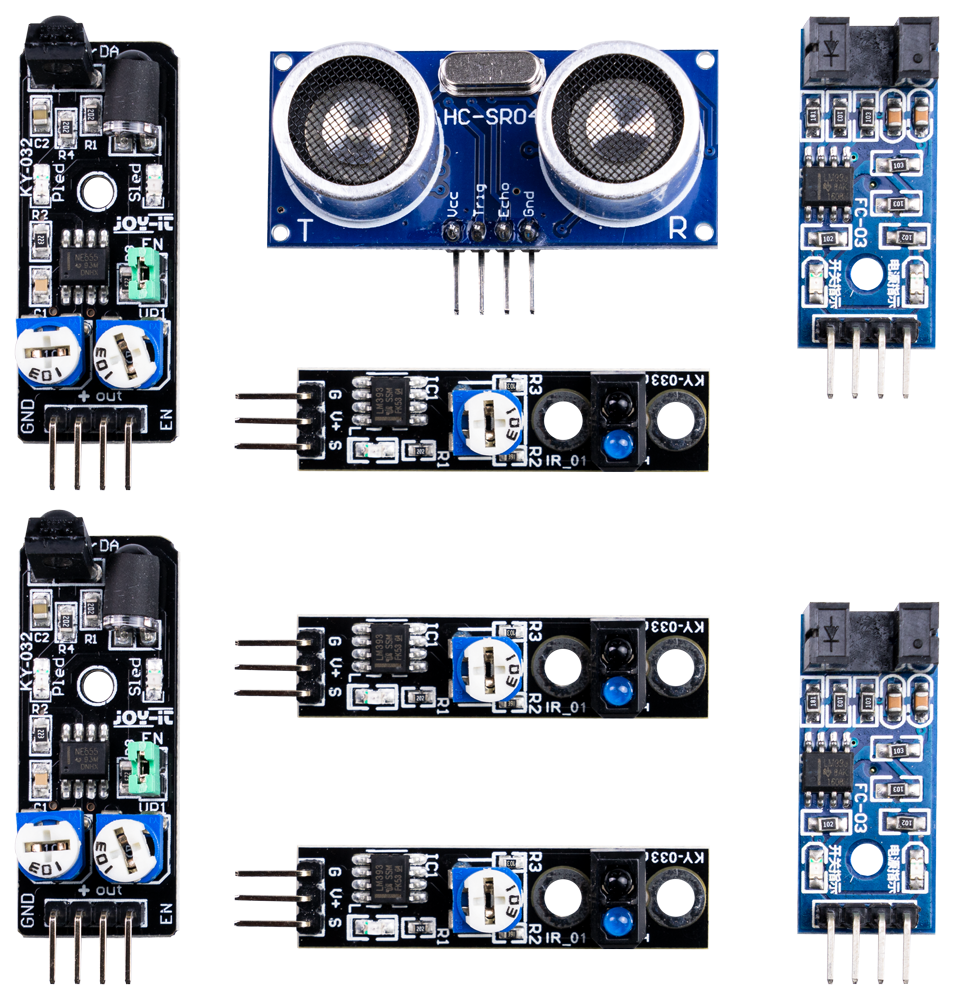
The Joy-Car is an autonomous education robot based on Micro:Bit and offers a modular robotics learning kit. With the help of the detailed and extensive manual, all assemblies and their functions as a whole machine are explained, as well as details on programming and codes. Sensors such as line tracking, ultrasonic, infrared and wheel speed sensors enable functions such as autonomous driving and even control via BT using a second, separate Micro:Bit. The additional equipment simulates turn signals, lights, reversing light and horn, thus rounding off the experience of an autonomous robot car. By using addressable LEDs, individual lighting scenarios can also be realized.
Features
Sensors
The Joy-Car has different sensors that allow you to react to certain events. These include the detection of obstacles, lines, markings, distances and speed. Only the different sensors enable the Joy-Car to use its autonomous functions.
Car functions
Use the joy car to simulate real car functions. The four LED modules with a total of 8 individual LEDs can be used to simulate light functions such as low beam, brake light, turn indicators and reversing light. The sensors can perform autonomous functions such as distance measurement, speed regulation, parking assistants and more. There are no limits to the possibilities.
Education
In addition to the numerous functions of the Joy-Car, the comprehensive manual rounds off the complete package. Besides the detailed assembly instructions, all technical areas of the joy car are explained. Functional principles of the individual sensors and the communication of all electronic components are explained in detail. Also the programming does not fall short here. From beginning to end, all necessary steps and possible functions are explained here, so that even beginners are well supplied with the Joy-Car.
Experts
But even experts do not fall short here. In addition to the explanations of the technical components, the manual also contains all details about the mainboard of the joy car. Own extensions and modifications are no problem. Even the programming is fast and easy for advanced users due to our extensive programming examples for MicroPython.
Extensions
You have no programming experience yet? No problem! We show you step by step how everything works. With our own MakeCode extension you can easily develop your own joy car program. And the best: You don't have to write a single line of code if you don't want to! So don't worry, bringing your own Joy-Car to life is very easy.
Remote control
You want a little more variety? No problem, you don't have to rely solely on programming the autonomous functions. You can turn an optional separate micro:bit into a remote control for your joy car in no time. Here you can then use the acceleration and tilt sensors to steer your joy car comfortably from a distance.
Centerpiece

The mainboard developed by us is the centerpiece of the Joy-Car. Beside a direct slot for the micro:bit, the mainboard is the central unit to which all electronics of the joy car are connected and controlled.
In addition to the connections for sensors, lighting and motors, there are also other connections that can be used for your own extensions. So the joy-car does not remain a closed system, but can be adapted to your own ideas.
We have followed this concept not only in the development of the mainboard, but also in the development of our programming. This can also be easily adapted and extended in Make:Code as well as in MicroPython. There are no limits to the possibilities!
Sensors

In addition to the main board and the various motors, the joy car has various sensors that enable it to perform its autonomous functions. They form, so to speak, the "eyes" of the Joy-Car.
These sensors include a distance sensor, obstacle sensors, line tracking sensors and speed sensors. Combined, these sensors unfold their full potential and allow the joy car to react to a wide variety of events. Detect obstacles in a far distance? Regulate speeds depending on possible blockades, line tracking, gap detection and parking functions? All this and much more is made possible by the sensors of the Joy-Car.